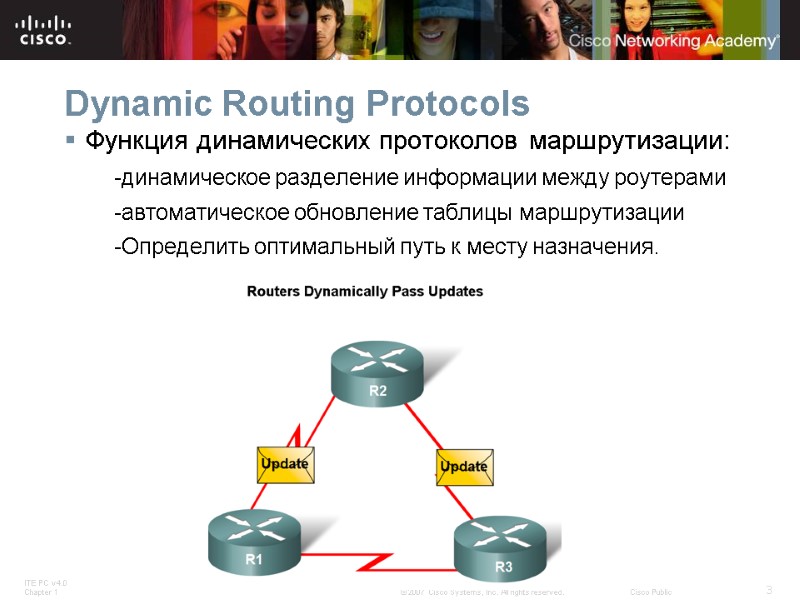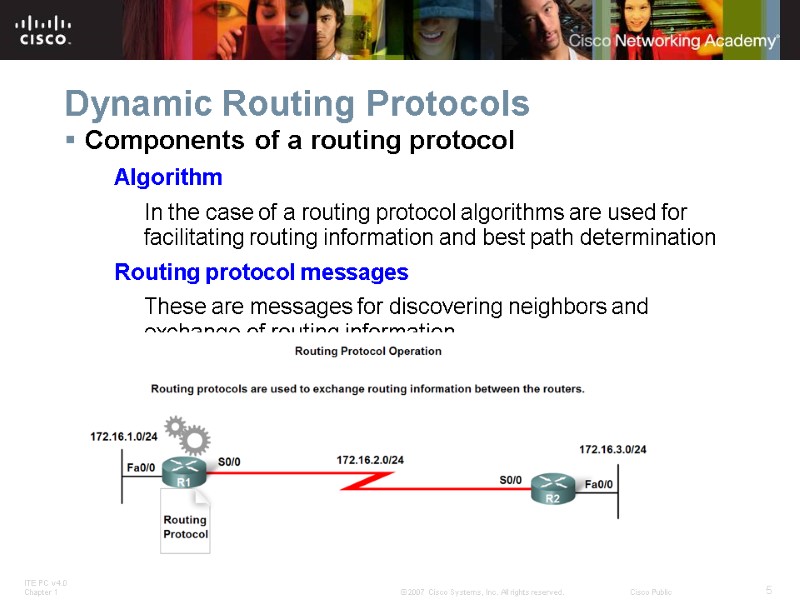Введение в динамическую маршрутизацию Routing Protocols and Concepts


























726-exploration_routing_chapter_3.ppt
- Количество слайдов: 25
 Введение в динамическую маршрутизацию Routing Protocols and Concepts – Chapter 3
Введение в динамическую маршрутизацию Routing Protocols and Concepts – Chapter 3
 Цель Описать роль протоколов динамической маршрутизации и поместить эти протоколы в контексте современного дизайна сети. Выделяют несколько способов классификации протоколов маршрутизации. Описать, как метрики используют протоколы маршрутизации и определить типы метрик используемых протоколами динамической маршрутизации. Определить административное расстояние маршрута и описать его значение в процессе маршрутизации. Определить различные элементы таблицы маршрутизации.
Цель Описать роль протоколов динамической маршрутизации и поместить эти протоколы в контексте современного дизайна сети. Выделяют несколько способов классификации протоколов маршрутизации. Описать, как метрики используют протоколы маршрутизации и определить типы метрик используемых протоколами динамической маршрутизации. Определить административное расстояние маршрута и описать его значение в процессе маршрутизации. Определить различные элементы таблицы маршрутизации.
 Dynamic Routing Protocols Функция динамических протоколов маршрутизации: -динамическое разделение информации между роутерами -автоматическое обновление таблицы маршрутизации -Определить оптимальный путь к месту назначения.
Dynamic Routing Protocols Функция динамических протоколов маршрутизации: -динамическое разделение информации между роутерами -автоматическое обновление таблицы маршрутизации -Определить оптимальный путь к месту назначения.
 Dynamic Routing Protocols Целью протокола динамической маршрутизации заключается в следующем: -обнаружение удаленных сетей -Поддержание последнюю дату маршрутной информации -Выбор наилучшего пути к сети назначения -Возможность найти новый лучший путь, если текущий путь больше не доступны
Dynamic Routing Protocols Целью протокола динамической маршрутизации заключается в следующем: -обнаружение удаленных сетей -Поддержание последнюю дату маршрутной информации -Выбор наилучшего пути к сети назначения -Возможность найти новый лучший путь, если текущий путь больше не доступны
 Dynamic Routing Protocols Components of a routing protocol Algorithm In the case of a routing protocol algorithms are used for facilitating routing information and best path determination Routing protocol messages These are messages for discovering neighbors and exchange of routing information
Dynamic Routing Protocols Components of a routing protocol Algorithm In the case of a routing protocol algorithms are used for facilitating routing information and best path determination Routing protocol messages These are messages for discovering neighbors and exchange of routing information
 Dynamic Routing Protocols Advantages of static routing -It can backup multiple interfaces/networks on a router -Easy to configure -No extra resources are needed -More secure Disadvantages of static routing -Network changes require manual reconfiguration -Does not scale well in large topologies
Dynamic Routing Protocols Advantages of static routing -It can backup multiple interfaces/networks on a router -Easy to configure -No extra resources are needed -More secure Disadvantages of static routing -Network changes require manual reconfiguration -Does not scale well in large topologies
 Classifying Routing Protocols Dynamic routing protocols are grouped according to characteristics. Examples include: -RIP -IGRP -EIGRP -OSPF -IS-IS -BGP Autonomous System is a group of routers under the control of a single authority.
Classifying Routing Protocols Dynamic routing protocols are grouped according to characteristics. Examples include: -RIP -IGRP -EIGRP -OSPF -IS-IS -BGP Autonomous System is a group of routers under the control of a single authority.
 Classifying Routing Protocols Types of routing protocols: -Interior Gateway Protocols (IGP) -Exterior Gateway Protocols (EGP)
Classifying Routing Protocols Types of routing protocols: -Interior Gateway Protocols (IGP) -Exterior Gateway Protocols (EGP)
 Classifying Routing Protocols Interior Gateway Routing Protocols (IGP) -Used for routing inside an autonomous system & used to route within the individual networks themselves. -Examples: RIP, EIGRP, OSPF Exterior Routing Protocols (EGP) -Used for routing between autonomous systems -Example: BGPv4
Classifying Routing Protocols Interior Gateway Routing Protocols (IGP) -Used for routing inside an autonomous system & used to route within the individual networks themselves. -Examples: RIP, EIGRP, OSPF Exterior Routing Protocols (EGP) -Used for routing between autonomous systems -Example: BGPv4
 Classifying Routing Protocols IGP: Comparison of Distance Vector & Link State Routing Protocols Distance vector routes are advertised as vectors of distance & direction. incomplete view of network topology. Generally, periodic updates. Link state complete view of network topology is created. updates are not periodic.
Classifying Routing Protocols IGP: Comparison of Distance Vector & Link State Routing Protocols Distance vector routes are advertised as vectors of distance & direction. incomplete view of network topology. Generally, periodic updates. Link state complete view of network topology is created. updates are not periodic.
 Classifying Routing Protocols
Classifying Routing Protocols
 Classifying Routing Protocols Classful routing protocols Do NOT send subnet mask in routing updates Classless routing protocols Do send subnet mask in routing updates.
Classifying Routing Protocols Classful routing protocols Do NOT send subnet mask in routing updates Classless routing protocols Do send subnet mask in routing updates.
 Classifying Routing Protocols Convergence is defined as when all routers’ routing tables are at a state of consistency
Classifying Routing Protocols Convergence is defined as when all routers’ routing tables are at a state of consistency
 Routing Protocols Metrics Metric A value used by a routing protocol to determine which routes are better than others.
Routing Protocols Metrics Metric A value used by a routing protocol to determine which routes are better than others.
 Routing Protocols Metrics Metrics used in IP routing protocols -Bandwidth -Cost -Delay -Hop count -Load -Reliability
Routing Protocols Metrics Metrics used in IP routing protocols -Bandwidth -Cost -Delay -Hop count -Load -Reliability
 Routing Protocols Metrics The Metric Field in the Routing Table Metric used for each routing protocol -RIP - hop count -IGRP & EIGRP - Bandwidth (used by default), Delay (used by default), Load, Reliability -IS-IS & OSPF – Cost, Bandwidth (Cisco’s implementation)
Routing Protocols Metrics The Metric Field in the Routing Table Metric used for each routing protocol -RIP - hop count -IGRP & EIGRP - Bandwidth (used by default), Delay (used by default), Load, Reliability -IS-IS & OSPF – Cost, Bandwidth (Cisco’s implementation)
 Routing Protocols Metrics Load balancing This is the ability of a router to distribute packets among multiple same cost paths
Routing Protocols Metrics Load balancing This is the ability of a router to distribute packets among multiple same cost paths
 Administrative Distance of a Route Purpose of a metric It’s a calculated value used to determine the best path to a destination Purpose of Administrative Distance It’s a numeric value that specifies the preference of a particular route
Administrative Distance of a Route Purpose of a metric It’s a calculated value used to determine the best path to a destination Purpose of Administrative Distance It’s a numeric value that specifies the preference of a particular route
 Administrative Distance of a Route Identifying the Administrative Distance (AD) in a routing table It is the first number in the brackets in the routing table
Administrative Distance of a Route Identifying the Administrative Distance (AD) in a routing table It is the first number in the brackets in the routing table
 Administrative Distance of a Route Dynamic Routing Protocols
Administrative Distance of a Route Dynamic Routing Protocols
 Administrative Distance of a Route Directly connected routes Have a default AD of 0 Static Routes Administrative distance of a static route has a default value of 1
Administrative Distance of a Route Directly connected routes Have a default AD of 0 Static Routes Administrative distance of a static route has a default value of 1
 Administrative Distance of a Route Directly connected routes -Immediately appear in the routing table as soon as the interface is configured
Administrative Distance of a Route Directly connected routes -Immediately appear in the routing table as soon as the interface is configured
 Summary Dynamic routing protocols fulfill the following functions -Dynamically share information between routers -Automatically update routing table when topology changes -Determine best path to a destination Routing protocols are grouped as either -Interior gateway protocols (IGP)Or -Exterior gateway protocols(EGP) Types of IGPs include -Classless routing protocols - these protocols include subnet mask in routing updates -Classful routing protocols - these protocols do not include subnet mask in routing update
Summary Dynamic routing protocols fulfill the following functions -Dynamically share information between routers -Automatically update routing table when topology changes -Determine best path to a destination Routing protocols are grouped as either -Interior gateway protocols (IGP)Or -Exterior gateway protocols(EGP) Types of IGPs include -Classless routing protocols - these protocols include subnet mask in routing updates -Classful routing protocols - these protocols do not include subnet mask in routing update
 Summary Metrics are used by dynamic routing protocols to calculate the best path to a destination. Administrative distance is an integer value that is used to indicate a router’s “trustworthiness” Components of a routing table include: -Route source -Administrative distance -Metric
Summary Metrics are used by dynamic routing protocols to calculate the best path to a destination. Administrative distance is an integer value that is used to indicate a router’s “trustworthiness” Components of a routing table include: -Route source -Administrative distance -Metric


